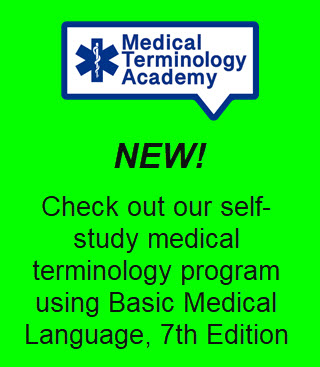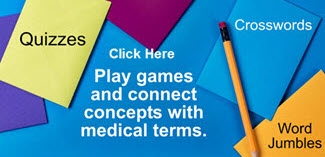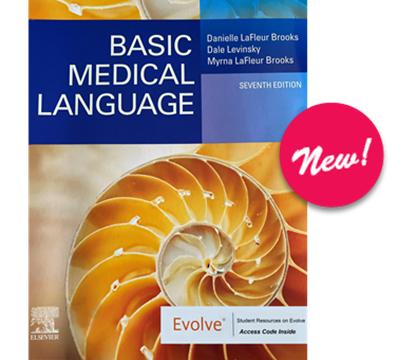Exploring Medical Language
By Myrna LaFleur Brooks, RN, BEd and Danielle LaFleur Brooks, MEd, MATLA
 Exploring Medical Language is a leading textbook in medical terminology, used in colleges, universities, high schools, and individually since 1985, published by Elsevier/Mosby. This 800 page textbook is deal for 2 or 3 credit courses.
Exploring Medical Language is a leading textbook in medical terminology, used in colleges, universities, high schools, and individually since 1985, published by Elsevier/Mosby. This 800 page textbook is deal for 2 or 3 credit courses.
Extra for Students: Online program with games, electronic health records, pronunciation and spelling practice, flashcards, practice quizzes and more.
Extra for Faculty: Online lesson plans, handouts, PowerPoint, gradable quizzes and test bank.
Click on the Google icon below to see a preview of Exploring Medical Language

Description
With Exploring Medical Language, 10th Edition, you can now master medical terms on your terms! At the heart of this one-of-a-kind learning package is an innovative worktext, which enables you to gradually acquire an understanding of medical terminology by first learning word parts and then learning how to combine the parts into full medical terms that make sense. Perhaps even better is the wide range of engaging online learning tools — tools like interactive games, puzzles, application activities, and on-the-go auditory reviews — that come with the worktext to help reinforce your learning and help you understand how the terms are used in the professional world. In all, this is the only resource on the market that incorporates all the proven methods for mastering medical terminology that work best for today’s learners.
Key Features
- Systematic presentation of medical terminology provides a foundation of word parts (prefixes, suffixes, and word roots), then builds words by combining the parts.
- Comprehensive coverage of words that are built from word parts and other important terms creates a distinction between terms built from word parts and those not easily recognized as built from word parts and provides thorough coverage of both.
- Over 400 flashcards enable readers to review word parts when and where they want.
- Margin boxes detail important information such as medical terminology facts and tips, historical information, weblinks, and complementary and alternative medicine terms.
- Simulations of electronic health records familiarize readers with the growing use of EHRs in healthcare settings.
- AudioTerms study companion can be easily downloaded to portable media players and includes over 3,000 terms, each of which is pronounced and defined.
- Integrated online learning tools feature interactive games and activities, A+P boosters, career videos, and more that cater to the way today’s learners master medical terminology.
Table of Contents
1. Introduction to Medical Language and Online Learning
2. Body Structure, Color, and Oncology
3. Directional Terms, Planes, Positions, Regions, and Quadrants
4. Integumentary System
5. Respiratory System and Introduction to Diagnostic Procedures and Tests
6. Urinary System
7. Male Reproductive System
8. Female Reproductive System
9. Obstetrics and Neonatology
10. Cardiovascular, Immune, Lymphatic Systems and Blood
11. Digestive System
12. Eye
13. Ear
14. Musculoskeletal System
15. Nervous System and Behavioral Health
16. Endocrine System
About the Author
Myrna LaFleur Brooks
Affiliations and Expertise
Founding President of the National Association of Health Unit Clerks/Coordinators, Faculty Emeritus, Maricopa County Community College District, Phoenix, AZ
“I am Myrna LaFleur Brooks, nurse, educator, author…, and now a blogger.”
Let me share with you a little bit about myself.
Early Life, Education, and Work

I grew up on a farm in Saskatchewan, Canada, (I still love open spaces)and graduated from the Grey Nuns’ School of Nursing in Regina, the city closest to my home.
After a few years of bedside nursing and travel, I settled in Phoenix, Ariz., where I pursued a degree in education from Northern Arizona University, worked as a bedside nurse, directed a hospital staff development program, and spent 27 years as faculty and Chair of the Health Science Division, Maricopa County Community College District.
Medical Terminology
I first taught medical terminology in 1970, a two-credit course using the textbook titled, The Elements of Scientific and Specialized Terminology by Brunner and Berkowitz. It introduced me to teaching medical terminology using the word part method. Since the book only dealt with terms built from word parts, I was interested in a book that would broaden the offering to medical terms not built from word parts. Unable to find such a text, my teaching partner, Winnie Starr and I sent a proposal for such to Mosby Inc., got accepted, and began writing the text titled Exploring Medical Language, A Student-Directed Approach, in 1983. The first edition was published in 1985 and is now is in the 10th edition. I have the great privilege of co-authoring the textbook with my daughter Danielle LaFleur Brooks.
In 1996, a second medical terminology text, Basic Medical Language, was published, co-authored by Danielle, and is now in its 5th edition.
I am also the original coauthor (I no longer write the revisions) of LaFleur Brooks’ Health Unit Coordinating. The national exposure from the publishing of this textbook led me to become the founding president of the National Association of Health Unit Coordinators.
Now
I spend my time researching and writing blog posts for MedTermTopics which was launched two years ago. I am excited about its success and we have just revised the site for easier navigation and an updated look.
I love the language of medicine and I appreciate its importance as a language in communicating inside and outside the medical field. How many medical terms are built from word parts, the origin of terms, new and emerging terms, and how the language is learned are all areas I can explore with the blog. Please join me in this exploration and sign up to receive free blog posts every other week.
Danielle LaFleur Brooks
Affiliations and Expertise
Faculty, Medical Assisting and Allied Health and Science Community College of Vermont Montpelier, Vermont
Danielle LaFleur Brooks
 “My love of language, medical and otherwise, has led me to many interesting places academically and professionally.”
“My love of language, medical and otherwise, has led me to many interesting places academically and professionally.”
I am deeply interested in medical language, clinically and metaphorically, and I have had the opportunity to work with this concept through writing textbooks and facilitating writing programs for patients and healthcare professionals.
In addition to teaching medical assisting courses for the Community College of Vermont, I have taught at Goddard College in the Education and Licensure Program and the Health Arts and Science Program. I also had the opportunity to develop and facilitate the Greater Phoenix Area’s Young Adult Writers Program for Arizona State University for several years. For the last ten years, I have been immersed in medical terminology as well as engaged in my teaching activities, recently completing the revision of Exploring Medical Language. I just finished revising Basic Medical Language, Fifth Edition.
Textbook writing is such a creative process! I love thinking about the content and how best to serve the student new to medical language. I have also had the opportunity to design instructor’s materials, build test banks, review online courses, design online games, and create companion websites. It has been an engaging curriculum development process, which provides an excellent opportunity to practice what I know about learning and teaching.
In addition to writing and teaching, I am a full-time mother to a third-grader and preschooler. I fully understand the balancing act required to meet professional, academic, and family responsibilities. And though I am thoroughly dedicated to my academic and professional roles, being “Mommy” brings me boundless joy.
Publications: Co-author, Exploring Medical Language and Basic Medical Language.
Educational Background: MA, Transformative Language Arts, Goddard College; MEd, Secondary Education, Arizona State University; BS, Business and Public Administration, University of Arizona.
“I am Myrna LaFleur Brooks, nurse, educator, author…, and now a blogger.”
Let me share with you a little bit about myself.
Early Life, Education, and Work

I grew up on a farm in Saskatchewan, Canada, (I still love open spaces)and graduated from the Grey Nuns’ School of Nursing in Regina, the city closest to my home.
After a few years of bedside nursing and travel, I settled in Phoenix, Ariz., where I pursued a degree in education from Northern Arizona University, worked as a bedside nurse, directed a hospital staff development program, and spent 27 years as faculty and Chair of the Health Science Division, Maricopa County Community College District.
Medical Terminology
I first taught medical terminology in 1970, a two-credit course using the textbook titled, The Elements of Scientific and Specialized Terminology by Brunner and Berkowitz. It introduced me to teaching medical terminology using the word part method. Since the book only dealt with terms built from word parts, I was interested in a book that would broaden the offering to medical terms not built from word parts. Unable to find such a text, my teaching partner, Winnie Starr and I sent a proposal for such to Mosby Inc., got accepted, and began writing the text titled Exploring Medical Language, A Student-Directed Approach, in 1983. The first edition was published in 1985 and is now is in the 10th edition. I have the great privilege of co-authoring the textbook with my daughter Danielle LaFleur Brooks.
In 1996, a second medical terminology text, Basic Medical Language, was published, co-authored by Danielle, and is now in its 5th edition.
I am also the original coauthor (I no longer write the revisions) of LaFleur Brooks’ Health Unit Coordinating. The national exposure from the publishing of this textbook led me to become the founding president of the National Association of Health Unit Coordinators.
Now
I spend my time researching and writing blog posts for MedTermTopics which was launched two years ago. I am excited about its success and we have just revised the site for easier navigation and an updated look.
I love the language of medicine and I appreciate its importance as a language in communicating inside and outside the medical field. How many medical terms are built from word parts, the origin of terms, new and emerging terms, and how the language is learned are all areas I can explore with the blog. Please join me in this exploration and sign up to receive free blog posts every other week.
Details
- No. of pages: 800
- Copyright:© Mosby 2018
- Published: 14th February 2017
- Imprint: Mosby
- eBook ISBN: 9780323415750
- eBook ISBN: 9780323415736
- Paperback ISBN: 9780323396455
Includes: Online Learning Tools and Paper and Electronic Flashcards




